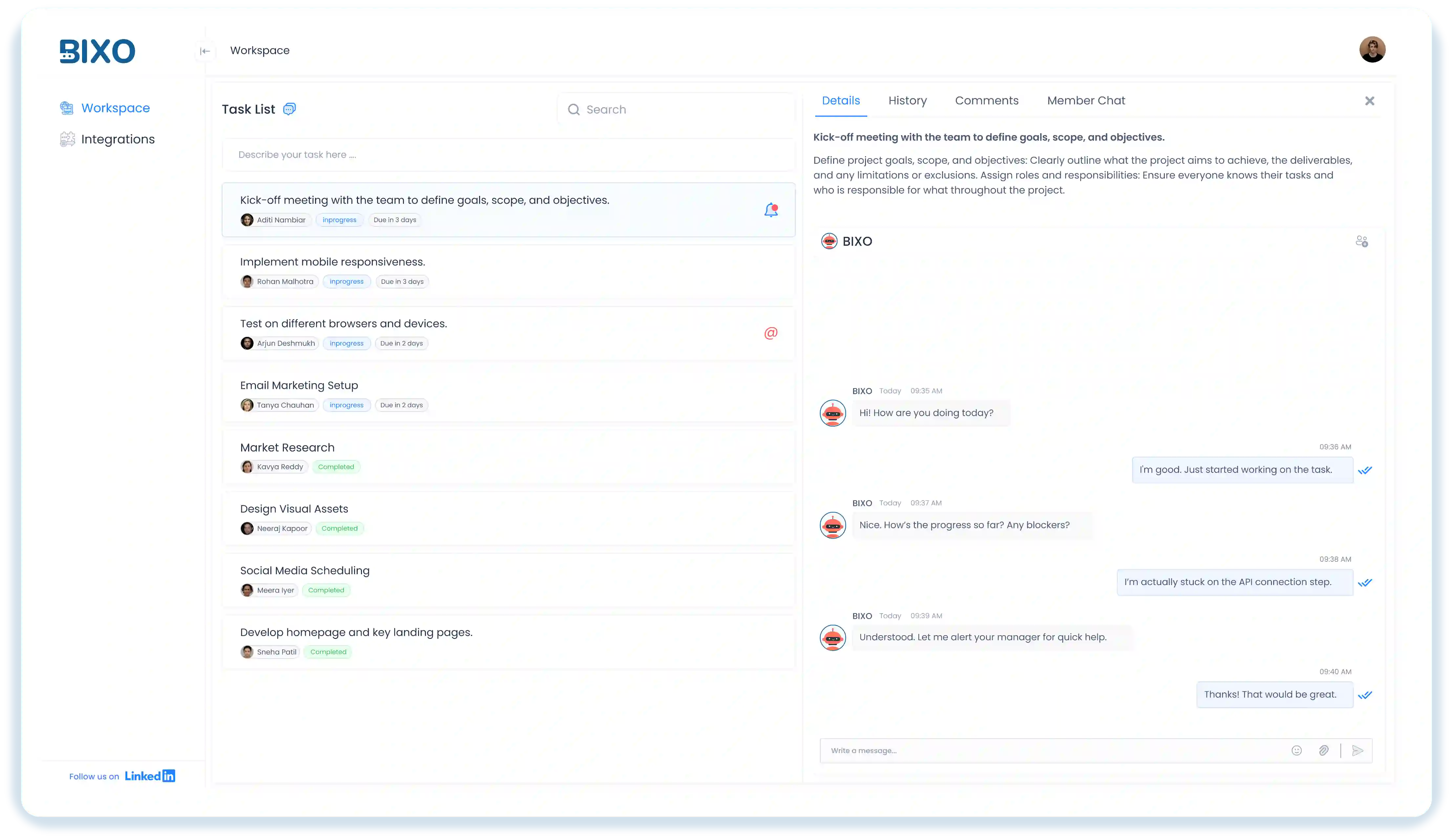
Table of Content
Focus on what matters. BIXO handles the rest!

Projects are rarely completed exactly as planned. Unexpected problems can cause delays, extra costs, or stress for you and your team. Using the right risk management strategies helps you to spot these problems early, plan smart solutions, and keep your project on track.
Risk management strategy is a plan that you use to identify, evaluate, and address possible issues in your projects. It assists you in planning ahead of unexpected problems, reducing delays, and protecting your project resources.
By following the right strategies, you can reduce risks, protect your resources, and reach your goals more confidently. In this guide, you’ll learn about 7 proven risk management strategies that make managing risks easier, faster, and more effective for every project you handle.
What Are the Different Types of Risk Management Strategies?
There are several ways to handle risks in your projects. Understanding the different types of risk management strategies helps you to pick the right approach for each situation.

Risk Avoidance
Sometimes the best way to manage a risk is to completely avoid it. This means stopping activities that could create problems or changing your plan to remove the entire risk. For example, if a supplier is not trustworthy, you don't want to work with them at all. Avoidance is not always possible, but when you try to avoid the risk, it can save you from future issues. It works as a practical risk management strategy example because it prevents risks before they occur.
Risk Reduction
Risk reduction is focused on reducing the chances of problems or the effects of risks. Instead of completely avoiding them, you can simply take a few steps to make them less harmful. For example, adding security measures will decrease the risk of a cyberattack. This approach is one of the most effective risk mitigation strategies in project management because it helps you to continue your work with fewer interruptions while still preparing for possible challenges.
Risk Transference
In this strategy, you shift the responsibility of handling a risk to someone else. The most common way is by handing over certain tasks to third parties who can handle those risks more effectively. Transference is useful when risks are too costly or complex for your team. This is a best fit under risk response strategies in project management because it allows you to share the burden with another party.
Risk Acceptance
Sometimes, you may decide to accept a risk instead of avoiding or reducing it. This happens when the damage from the risk would be less serious than the resources needed to prevent it. For example, you might accept small delays in a project if fixing them would require too many resources. Acceptance is an important part of risk management because not every risk can be removed, and some can only be managed when they happen.
Contingency Planning
Contingency planning means having a backup plan ready in case sudden risks occur. For example, if your main supplier fails, you already know which alternate supplier you can call immediately. This shows how strong risk response strategies in project management can be. Instead of feeling stressed, you have an instant solution that keeps the project running smoothly.
Business Experiments
Sometimes a business tries out new ideas on a small scale before making a big investment. This helps you see what problems can arise and how to fix them early. This approach is a smart risk management strategy example because you test safely, learn from the results, and improve your plans without facing big losses.
Data Analysis
Data plays a big role in today’s risk management strategies. By tracking past events, trends, and performance, you can predict risks before they happen. For example, analysing financial records can help to spot the credit risks. This approach supports risk mitigation strategies in project management, as it helps you to make better decisions with real information instead of assumptions.
Who Should Be Responsible for Developing Risk Response Strategies?
Developing strong risk response strategies in project management is not the work of one person alone. It needs teamwork from different levels of your organisation for more effectiveness. From leaders to employees, every role adds value in spotting, managing, and reducing risks.
Company Leaders
Top executives such as the CEO, CFO, or CIO are key players in building effective risk management strategies. Their vision helps to ensure that risk plans support business goals and long-term growth. Team Leads also provide the resources and direction needed for the strategies to succeed. By being actively involved, leaders set the foundation for the entire organisation. If you are a leader who prioritises risks, it encourages the whole team to follow. This makes risk mitigation strategies in project management stronger and more consistent.
Team Managers
Managers are involved in daily operations and therefore they understand the risk that exists in a specific department or project. They can identify problems in advance, such as resource shortages, delays, and operational risks, and communicate about the risks effectively for faster solutions. Risk management strategies are more realistic when managers share their knowledge. Their contribution makes the plans not only theoretical but also practical in real project environments.
The Board
The board of directors provides guidance and makes sure that the risk policies are followed correctly. Their responsibility is to check the relationship between risk response strategies in project management (keyword) that are connected with stakeholders. Their participation brings accountability and governance to the process. With transparent and honest strategies, the board establishes trust with both employees and external partners.
Employees
The employees are the people who deal with daily activities and challenges, hence they are crucial in identifying the risks quickly. They can identify inefficiencies, errors or possible problems before they turn into larger problems. The more the employees communicate about the issues, the more effective the risk management strategies. Their participation ensures that risk management is a team-based responsibility rather than controlled only by leaders.
Compliance and Audit Teams
Compliance and audit teams make sure your business follows laws, rules, and internal policies. They play a key role in identifying risks connected to rule violations and avoiding cost problems. By monitoring closely, they add a protective layer to your risk management strategies. Their expertise ensures that the strategies are not only strong but also ethical and match industry requirements.
Spot Project Risks Early Before They Impact Your Business with BIXO

Small risks can quietly grow into big problems if not managed at the correct time. BIXO helps you track those early warning signs, so no risk gets missed. Instead of reacting late, you’ll already have a steady plan before a risk occurs. With BIXO, you can track risks based on your goals, assign responsibility, and watch progress in real time. This makes your risk response strategies in project management more practical and keeps your team ready for any challenge.
Conclusion
Using effective risk management strategies helps you to keep your projects and business more secure. By spotting risks early and taking action, you can avoid issues, secure your resources, and keep operations running smoothly. Using tools like BIXO helps you stay ahead by identifying risks early, assigning responsibilities clearly, and taking timely action to keep every project running smoothly. Following the steps and approaches discussed in this guide helps you stay prepared, make smarter decisions, and achieve project success with confidence. Consistently applying these strategies ensures long-term growth and stability for your business.
FAQs
Risk avoidance means choosing not to engage with the activities that could cause problems. For example, avoiding unreliable suppliers prevents delays and financial losses.
Yes, tools like BIXO help you to implement risk management strategies by tracking risks, monitoring controls, and keeping your projects on track and organised.
Risk transference means shifting the risk to someone else, for example, through insurance or by hiring external experts. Risk mitigation means reducing the impact of a risk without transferring it.
Yes! By applying risk mitigation strategies, you can reduce unexpected problems, protect assets, and show clients that your projects are reliable, boosting confidence and loyalty.
Get a demo of BIXO
Recommended Blogs

Top 7 AI Project Mangement Assistants
Users can keep their tasks arranged, check the project’s progress and stay in touch with the team using BIXO’s automated messages.

What Is an AI Task Manager Tools & Tips to Boost Productivity
Users can keep their tasks arranged, check the project’s progress and stay in touch with the team using BIXO’s automated messages.

12 Best To Do List Apps That Help Managers in 2025
Users can keep their tasks arranged, check the project’s progress and stay in touch with the team using BIXO’s automated messages.


